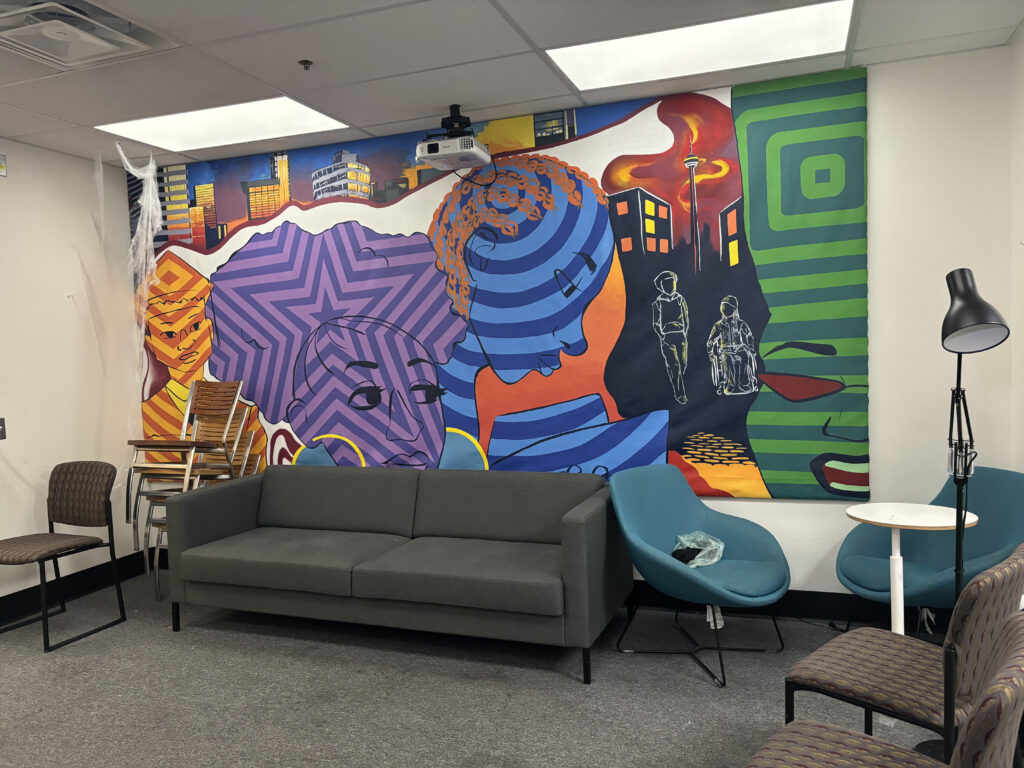
Listen to the whole story here:
With the Black Student Lounge (BSL) offering space for a maximum of 30 people, Black Toronto Metropolitan University (TMU) students want a larger space to accommodate the growing number of Black students on campus.
According to 2019 numbers released by TMU, 8 per cent of the GTA population self-identifies as Black, while 7 per cent of undergraduate students and 4 per cent of graduate students self-identify as Black. An updated document from 2023 says the numbers are steady, with a slight uptick to 8 per cent for the number of Black undergraduate students and a bigger rise in the number of Black graduate students to 7 per cent.
The BSL is located at Kerr Hall West 77A, near the RAC’s swimming pool and measures 26×16 ft, which is space enough to host a couch, one computer, a kitchenette, working stations and board games, and was opened in 2023.
“I like the vision, but we’re gonna need more than one blanket, more than one couch and more than one computer,” said Luswaattaa Omorodion, a third-year Urban Planning student and user of the BSL.
“If we had a bigger space we could host events like game nights, movie nights, networking sessions [and more],” said Priscilla Komolafe-Dedricks, a third-year Business Management student and secretary for the African Student Association (ASA).
She points out that to be effective, the BSL needs to be a safe haven for Black TMU students to connect with one another and relate to experiences and challenges. “You can come [to] study and socialise. However, the two activities cannot coexist.”
According to TMU’s BSL webpage, the lounge “aims to counter the harms of institutional racism by creating safer spaces for healing and belonging.”
Aside from the BSL, TMU’s other student lounges vary in size and resources.
The Media Production Lounge, for instance, has more space, and measures 28×19 ft, allowing for collaborative work and provides amenities that are equipped for the entire Media Production program, including audio suites.
The Science Lounge has a max capacity of 50 people, and measures 36×28 ft. It provides a relaxed environment with a computer, printer, coffee machine, couch, two rolling whiteboards, utensils, lab coats, snacks, bean bag chairs, and workstations for students to create and work with each other.
While the BSL is home to a comforting environment made for Black students to connect with others and relax, its capacity limitations play a factor in its ability to meet the needs of the growing population of Black students.
Komolafe-Dedricks adds that having a larger lounge with separate spaces for engaging in schoolwork and hanging out with friends would be a positive solution.
“I feel the room could use a lot of work in terms of ambience, organisation, and just more resources that people [who come here] can engage with,” said Omorodion. She would like to see a larger space.
And says she wishes there were additional resources like sensory objects, items inside the empty storage compartments or more on the wall – elements she says would elevate her experience when using the BSL.
When Omorodion viewed the BSL online and saw it in person, she was expecting something more spacious with multiple pieces of furniture and went on to say, “[the furniture seems] like they were just shoved in here.”
In comparison with other student lounges, the BSL lacks in terms of size, amenities, and an overall inviting atmosphere.
“It’s really, really nice and people actually know how to behave in the lounge,” said Fatima Ahmed, a first-year biology student speaking about her experience using the Science Lounge on an everyday basis.
Ahmed described the lounge as providing all the tools and amenities she needs and likes to spend the majority of her time on campus there.
Having visited the Programming lounge in the past, Ahmed compares the two, noting the Programming lounge being smaller in size, having less resources and bright lighting.
“The lounge is pretty small for the amount of people we have in Media Production, and I think that’s why a lot of people choose not to go there,” said Madison Comfort, a third-year Media Production student.
Comfort pointed out that the lounge is not very creative despite it being a Creative School lounge and said, “it almost feels neglected.”
Comfort has had the opportunity to visit other student lounges like the Journalism lounge saying, “If I was in journalism, that would be a place that I would actually want to go [to] and spend my time.”
The journalism lounge, in the Rogers Communications Centre, measures 22×19 ft and hosts several couches, a microwave and two large whiteboards. It serves the 400 or so students currently enrolled in the undergraduate and graduate journalism programs.
“I can tell you that space is extremely limited on campus and we are always looking for ways to provide more space for learning and student experiences,” said president Mohamed Lachemi in an email to OTR.
Lachemi made sure to emphasise the university’s dedication in providing an inclusive space and access to resources for all students.
This article may have been created with the use of AI tools such as Google Docs, Grammarly, and/or Otter.ai for transcription.
